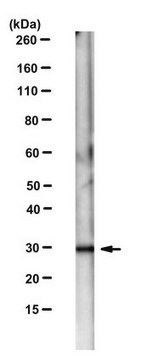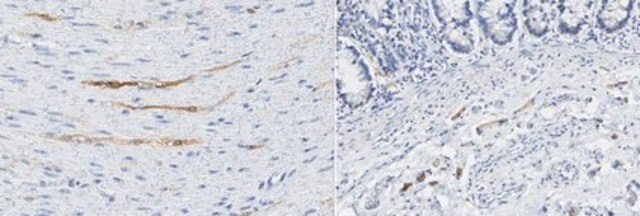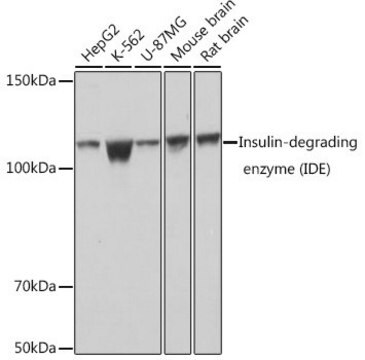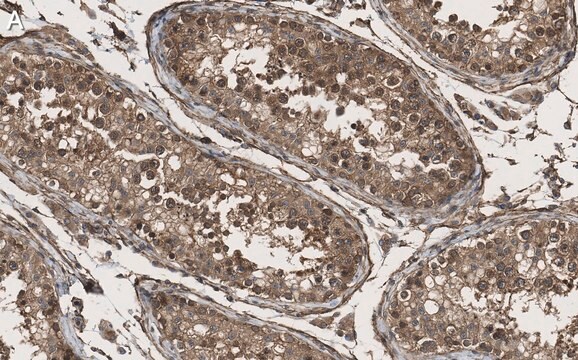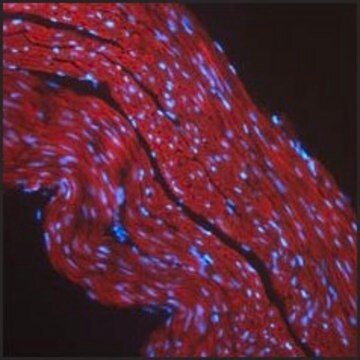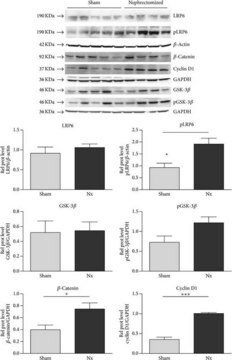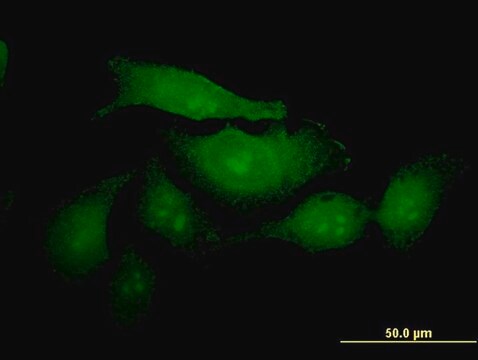MABT397
Anti-CEACAM1/CD66a Antibody, clone B3-17
clone B3-17, from mouse
Synonyme(s) :
Carcinoembryonic antigen-related cell adhesion molecule 1, Biliary glycoprotein 1, BGP-1, CD66a
About This Item
Produits recommandés
Source biologique
mouse
Niveau de qualité
Forme d'anticorps
purified immunoglobulin
Type de produit anticorps
primary antibodies
Clone
B3-17, monoclonal
Espèces réactives
human
Technique(s)
ELISA: suitable
flow cytometry: suitable
immunocytochemistry: suitable
immunohistochemistry: suitable (paraffin)
western blot: suitable
Isotype
IgG1κ
Numéro d'accès NCBI
Numéro d'accès UniProt
Conditions d'expédition
wet ice
Modification post-traductionnelle de la cible
unmodified
Informations sur le gène
human ... CEACAM1(634)
Catégories apparentées
Description générale
Immunogène
Application
Flow Cytometry Analysis: 10 µg/mL from a representative lot detected the exogenously expressed human CEACAM1/CD66a on the surface of transfected HeLa cells (Courtesy of Dr. B. Singer, University Duisburg-Essen, Germany).
Immunocytochemistry Analysis: 10 µg/mL from a representative lot detected CEACAM1/CD66a on the surface of HT-29 human colorectal carcinoma cells (Courtesy of Dr. B. Singer, University Duisburg-Essen, Germany).
Immunohistochemistry Analysis: 10 µg/mL from a representative lot detected CEACAM1/CD66a immunoreactivity in human jejunum tissue (Courtesy of Dr. B. Singer, University Duisburg-Essen, Germany).
Western Blotting Analysis: 10 µg/mL from a representative lot detected the exogensously expressed human CEACAM1/CD66a extracellular domain-Fc fusion in lysates from transfected cells (Courtesy of Dr. B. Singer, University Duisburg-Essen, Germany).
Flow Cytometry Analysis: Representative lots, either unconjugated or FITC-conjugated, detected CECAM1 immunoreactivity on the surface of human peripheral blood naïve and memory B-cells (Khairnar, V., et al. (2015). Nat. Commun. 6:6217; Seifert, M., et al. (2015). Proc. Natl. Acad. Sci. 112(6):E546-555).
Flow Cytometry Analysis: A representative lot detected CEACAM1/CD66a induction on the surface of normal human bronchial epithelial (NHBE) cells stimulated with poly(I:C) or interferons (Klaile, E., et al. (2013) Respir Res. 14:85).
Flow Cytometry Analysis: A representative lot detected CEACAM1/CD66a expression on the surface of 2 day-starved human epithelial (HT29, T102/3) and endothelial (AS-M.5) cells, as well as multivesicular bodies (MVBs) derived from these cells (Muturi H.T., et al. (2013) PLoS One. 8(9):e74654).
Immunocytochemistry Analysis: A representative lot detected CEACAM1/CD66a immunoreactivity on the surface of normal human bronchial epithelial (NHBE) cells by indirect immunofluorescence staining (Klaile, E., et al. (2013) Respir Res. 14:85).
Immunohistochemistry Analysis: A representative lot detected CEACAM1/CD66a in paraffin-embedded human lung cancer tissue sections (Klaile, E., et al. (2013) Respir Res. 14:85).
Western Blot Analysis: A representative lot detected CEACAM1/CD66a in 2 day-starved AS-M.5 human endothelialn cells and AS-M.5-derived multivesicular bodies (MVBs) (Muturi H.T., et al. (2013) PLoS One. 8(9):e74654).
Qualité
Western Blotting Analysis: 2 µg/mL of this antibody detected CEACAM1/CD66a in 10 µg of HepG2 cell lysate.
Description de la cible
Forme physique
Autres remarques
Vous ne trouvez pas le bon produit ?
Essayez notre Outil de sélection de produits.
Code de la classe de stockage
12 - Non Combustible Liquids
Classe de danger pour l'eau (WGK)
WGK 1
Point d'éclair (°F)
Not applicable
Point d'éclair (°C)
Not applicable
Certificats d'analyse (COA)
Recherchez un Certificats d'analyse (COA) en saisissant le numéro de lot du produit. Les numéros de lot figurent sur l'étiquette du produit après les mots "Lot" ou "Batch".
Déjà en possession de ce produit ?
Retrouvez la documentation relative aux produits que vous avez récemment achetés dans la Bibliothèque de documents.
Notre équipe de scientifiques dispose d'une expérience dans tous les secteurs de la recherche, notamment en sciences de la vie, science des matériaux, synthèse chimique, chromatographie, analyse et dans de nombreux autres domaines..
Contacter notre Service technique